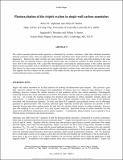Photoexcitation of the triplet exciton in single wall carbon nanotubes
Author(s)
Santos, Tiffany S.; Moodera, Jagadeesh; Mohite, Aditya D.; Alphenaar, Bruce W.
DownloadAlphenaar-2009-Photoexcitation of the triplet exciton in single wall carbon nanotubes.pdf (826.9Kb)
PUBLISHER_POLICY
Publisher Policy
Article is made available in accordance with the publisher's policy and may be subject to US copyright law. Please refer to the publisher's site for terms of use.
Terms of use
Metadata
Show full item recordAbstract
The carbon nanotube photoexcitation spectrum is dominated by excitonic transitions, rather than interband transitions between continuum states. There are eight distinct excitonic transitions (four singlet and four triplet), each with two-fold degeneracy. Because the triplet excitons are spin polarized with electron and hole spins both pointing in the same direction, they are optically inactive, and optical spectroscopy has revealed no evidence for their existence. Here, we show that by the interaction with a spin filter ferromagnetic semiconductor, photoexcitation of the carbon nanotube triplet exciton is possible, and its contribution to the photocurrent can be detected. The perturbation provided by the spin filter allows for inter-system mixing between the singlet and triplet excitonic states, and relaxes the spin selection rules. This supplies the first evidence for the existence of the triplet exciton, and provides an avenue for the optical excitation of spin polarized carriers in carbon nanotubes.
Date issued
2009-08Department
Francis Bitter Magnet Laboratory (Massachusetts Institute of Technology)Journal
Proceedings of SPIE
Publisher
The International Society for Optical Engineering
Citation
Alphenaar, Bruce W. et al. “Photoexcitation of the triplet exciton in single wall carbon nanotubes.” Physical Chemistry of Interfaces and Nanomaterials VIII. Ed. Oliver L. A. Monti & Oleg V. Prezhdo. San Diego, CA, USA: SPIE, 2009. 739607-9. © 2009 SPIE--The International Society for Optical Engineering
Version: Final published version
ISSN
0277-786X